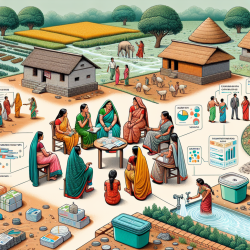Introduction
Menstruation is a natural process, yet it remains a significant public health issue, especially in low and middle-income countries (LMICs). A recent study titled "Assessing Women’s Menstruation Concerns and Experiences in Rural India: Development and Validation of a Menstrual Insecurity Measure" sheds light on the challenges faced by women in rural Odisha, India. This blog explores the implications of this research for practitioners and encourages further investigation into menstrual health.
The Research
The study developed a Menstrual Insecurity Measure to quantitatively assess the concerns and experiences of menstruating women in rural Odisha. Using cross-sectional data from 878 women, the researchers conducted Exploratory and Confirmatory Factor Analyses to identify a 19-item, five-factor model that best fit the data. The factors included Management, Menstrual Cycle Concerns, Symptoms, Restrictions, and Menstruation-Related Bodily Concerns.
Key Findings
The research highlighted several critical insights:
- Women without access to functional latrines, enclosed bathing spaces, or a water source within their compound, and those using reusable cloths, reported higher Menstrual Insecurity scores.
- Experiencing tension at menstrual onset or difficulty doing regular work was associated with higher Menstrual Insecurity scores.
- The validated measure provides a comprehensive tool for assessing menstrual insecurity and can inform program design and policy-making.
Implications for Practitioners
For practitioners, this study underscores the importance of addressing the environmental and social factors contributing to menstrual insecurity. Here are some actionable steps:
- Advocate for improved sanitation facilities, including functional latrines and enclosed bathing spaces, to reduce menstrual insecurity.
- Promote the use of disposable pads where feasible, as they are associated with lower insecurity scores.
- Develop educational programs to alleviate tension and misconceptions about menstruation, enhancing women's confidence in managing their menstrual health.
Encouraging Further Research
This study opens the door for further research into the broader impacts of menstrual insecurity on women's health, education, and economic participation. Researchers are encouraged to explore the following areas:
- Longitudinal studies to assess the impact of improved sanitation on menstrual insecurity over time.
- Cross-cultural studies to validate the Menstrual Insecurity Measure in different contexts.
- Investigations into the psychological and social impacts of menstrual insecurity.
Conclusion
The development of a Menstrual Insecurity Measure is a significant step forward in understanding and addressing the challenges faced by menstruating women in rural India. By leveraging these insights, practitioners can design more effective interventions to improve menstrual health outcomes.
To read the original research paper, please follow this link: Assessing Women’s Menstruation Concerns and Experiences in Rural India: Development and Validation of a Menstrual Insecurity Measure.










